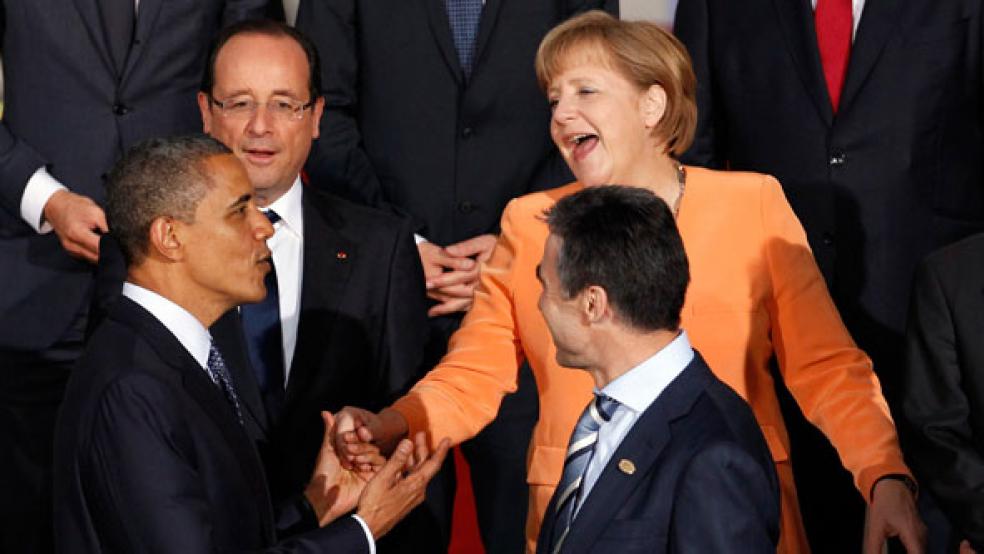The blockbuster bid for a U.S.-European Union trade deal announced by President Obama in Tuesday’s State of the Union speech won’t be easy, but it has the potential to reshape the global export market and provide a nudge to economies on both sides of the Atlantic.
The U.S. and European Union together already account for nearly half of global GDP and a third of global trade flows, with some $2.7 billion worth of goods and services exchanged daily. The agreement would increase trade between the partners by $120 billion within five years, according to a study by the U.S. Chamber of Commerce. At the same time, it would add some $180 billion to U.S.-EU gross domestic product. Estimates put forth by the European Commission suggest a new trade pact could increase annual GDP by 0.5 percent in the EU and 0.4 percent in the U.S. by 2027.
Getting even those modest benefits may be tricky, though. Negotiators striving to reach a deal within an aggressive two-year time frame will have to sort through a host of different regulatory standards, particularly regarding food and agriculture. As The Fiscal Times columnist Patrick Smith outlined recently, the EU’s regulatory regime is infinitely complicated, and progress in Brussels often moves at a snail’s pace. Europe has higher environmental standards and more restrictive regulations for many products, including pharmaceuticals. Obama administration officials have decried EU laws regarding data privacy as “digital protectionism” for European providers of cloud-computing services. There are also concerns about Europe’s soon-to-be-implemented financial transaction tax that will impose new liens on financial dealings in 11 European countries, including Germany and France.

Food Fight
The biggest sticking points, though, are bound to be the large cultural and regulatory differences in food standards. The EU has banned genetically engineered crops and importing beef treated with hormones. It also adheres to a “precautionary principle” that restricts food imports until strong scientific evidence proves they are safe. The U.S., by contrast, generally requires some scientific evidence of harm to ban foods, says Edward Alden, a senior fellow at the Council on Foreign Relations specializing in U.S. economic competitiveness. As a signal that it would be open to lowering barriers on food imports, the EU agreed this month to lift its ban on live pigs and beef carcasses washed in lactic acid.
The concerns aren’t only on the European side. Some lawmakers on Capitol Hill are already pushing back against some of the provisions that a final agreement will likely contain. In a letter to U.S. Trade Representative Ron Kirk this week, Sens. Max Baucus, D-Mont., and Orrin Hatch, R-Utah, wrote that opening up European markets to American agriculture would be key to securing approval for any trade deal. They also pointed to a need for agreement on strong intellectual property protection.
Given those thorny issues involved, Frances Burnwell, vice president of the Atlantic Council and director of the council’s Program on Transatlantic Relations says that the two-year time frame for the deal is ambitious, and that some areas of disagreement will be difficult to iron out. “It may be as we proceed through the negotiations, there are some persistent disagreements going on between the United States and the EU,” she said. “But these disputes impact less than 2 percent of our trade. Do you hold up the whole thing for 2 percent, or agree to disagree on those?”
Those persistent obstacles scuttled any chance for a deal in the past, but economic weakness on both sides of the Atlantic now provides fresh incentive for political leaders to push ahead, even if the path is strewn with potential stumbling blocks. “High level political commitment on these issues really matters,” says Alden. “You have for the first time in Europe a clear commitment, not only in Brussels but among the major leaders in the national capitals, that this is an economic priority for the European Union. They see this as an important source of potential growth at a time when a number of the European economies have been struggling.”
Alden also suggests that President Obama’s very public backing of the deal also offers an encouraging signal that economic imperatives will trump the litany of likely complications. “This is the first really new, ambitious trade-liberalizing initiative from this administration,” he says, “and that commitment, which has now been made personally by the president, really increases the pressure on his negotiators to try to bring home a deal.”
Ongoing negotiations between Canada and the EU on a trade deal may also help smooth a path for U.S. talks, according to Alden. “The Canadians are doing a certain amount of our work for us, because a lot of these issues are being hammered out in the Canada-EU negotiations, which are close to conclusion.”
It’s clear, though, that Obama is taking a gamble on the future of the European Union.
In order for any deal to deliver the promised benefits to U.S. businesses, the EU must prove a stable trading partner in the years to come. The crisis that threatened to break up the monetary union has calmed for the moment, but it is far from resolved. Right now, the EU’s future remains uncertain. On Thursday, Eurostat announced that economic growth in the fourth quarter of 2012 decreased by 0.6 percent. More importantly, Germany’s economy, the main engine of the European Union, also shrank by 0.6 percent, the biggest contraction since 2009.
Even so, Obama’s public support for the agreement in his State of the Union amounted to a vote of confidence that Europe had weathered the worst of the crisis and was now a partner in growth, says Peter Sparding, a transatlantic fellow in the German Marshall Fund’s Economic Policy Program. “From the European side, this was a huge thing. There were some in Europe who were afraid of losing the close attention of the United States,” Sparding said. “This was a signal that the United States is still invested in the old Cold War ties. It calmed some nerves in Europe.”
Raising Global Standards
If a trade pact is reached, it could also have broader global repercussions, creating de facto worldwide standards for products and agriculture that could force countries like China to improve their manufacturing practices in order to compete in Europe and America. “We need to work together on regulatory issues in terms of setting standards that will be standards for the global marketplace,” says the Atlantic Council’s Burnwell.
At the same time, removing tariffs, as envisioned in the agreement’s framework, would stimulate economic growth. Tariffs between the trading partners are already low, at an average of about 4 percent, but eliminating them altogether could help U.S.-based multinationals. “A lot of the tariffs hinder major companies like Procter & Gamble, Unilever and car companies who are shifting goods across the Atlantic,” Burnwell says. “The less they have in tariff fees, the more they have for investment and job creation.”
Business leaders and the U.S. Chamber of Commerce, which doesn’t typically get enthusiastic about international trade deals, praised the effort. “For the sake of jobs and growth, it’s time to forge a bold, new trade pact with Europe,” said Chamber of Commerce Chairman Thomas Donohue. “The stars are finally aligned.”





